Do you have a question about the ABB ProcessMaster FEP632 and is the answer not in the manual?
General guidelines and warnings for safe product handling and operation.
Details on the designated uses and prohibited applications of the device.
Description of integral and remote mount designs for ProcessMaster flowmeters.
Description of integral and remote mount designs for HygienicMaster flowmeters.
Safety warnings related to process conditions, live parts, and explosive atmospheres during installation.
Requirements for grounding, sensor insulation, and optimal inlet/outlet piping configurations.
Step-by-step instructions for the correct installation of the flowmeter sensor.
Guidelines for selecting a location and mounting the transmitter for remote mount configurations.
Procedures and safety warnings for opening and closing the device's housing cover.
Information on available plug-in cards and their installation for extending device functionality.
Safety instructions for electrical connections, including live parts and explosive atmospheres.
General information and importance of proper sensor grounding for measurement accuracy and safety.
Specific grounding procedures for metal pipes (fixed/loose flanges) and plastic/insulating pipes.
Specifications and connection details for the device's power supply.
Information on cable entry types, conduit connections, and general cable installation practices.
Detailed pin assignments for power, inputs/outputs, and signal cables.
Specifications for power supply options and electrical data for current outputs.
Configuration and operation of digital outputs and passive current outputs using plug-in modules.
Details on using plug-in cards for binary outputs and digital inputs.
Wiring diagrams and connection points for integral mount designs.
Wiring diagrams and connection points for remote mount design transmitters.
Overview of HART protocol, its limitations, and available output configurations.
Details on the Modbus protocol, its features, and configuration parameters.
Information on PROFIBUS DP protocol, device profiles, and required files.
Safety precautions for commissioning and hardware configuration using DIP switches.
Essential checks to perform before the initial commissioning of the device.
Steps for parameterizing the device using the local operating interface and a PC.
Methods for parameterizing the device using an infrared service port adapter or a HART modem.
Overview of factory default settings and guidance for configuring parameters via the Easy Setup menu.
Procedure for performing automatic zero point adjustment of the flowmeter sensor.
Safety precautions related to hot media and general device operation.
Information on interpreting error messages and switching to the configuration level for parameter changes.
Step-by-step guidance on selecting and changing parameters via table, numerical, and alphanumeric entries.
Detailed explanation of parameters configurable via the Easy Setup menu.
Configuration details for current outputs, including output mode and alarm settings.
Configuration of digital outputs for pulse, frequency, and logic modes, including alarm settings.
Procedure for calling up error details from the operator menu and interpreting error messages.
Classification of errors into groups (e.g., electronics) with their causes and remedies.
Introduction to advanced diagnostic functions like EPD, TFE, noise checks, and conductivity monitoring.
Safety precautions for maintenance activities, including live parts, Ex-approval, and hot media.
Safety guidelines for repair work and general maintenance checks for the sensor.
Instructions for sensor replacement and procedures for returning devices for service.
General guidelines and warnings for safe product handling and operation.
Details on the designated uses and prohibited applications of the device.
Description of integral and remote mount designs for ProcessMaster flowmeters.
Description of integral and remote mount designs for HygienicMaster flowmeters.
Safety warnings related to process conditions, live parts, and explosive atmospheres during installation.
Requirements for grounding, sensor insulation, and optimal inlet/outlet piping configurations.
Step-by-step instructions for the correct installation of the flowmeter sensor.
Guidelines for selecting a location and mounting the transmitter for remote mount configurations.
Procedures and safety warnings for opening and closing the device's housing cover.
Information on available plug-in cards and their installation for extending device functionality.
Safety instructions for electrical connections, including live parts and explosive atmospheres.
General information and importance of proper sensor grounding for measurement accuracy and safety.
Specific grounding procedures for metal pipes (fixed/loose flanges) and plastic/insulating pipes.
Specifications and connection details for the device's power supply.
Information on cable entry types, conduit connections, and general cable installation practices.
Detailed pin assignments for power, inputs/outputs, and signal cables.
Specifications for power supply options and electrical data for current outputs.
Configuration and operation of digital outputs and passive current outputs using plug-in modules.
Details on using plug-in cards for binary outputs and digital inputs.
Wiring diagrams and connection points for integral mount designs.
Wiring diagrams and connection points for remote mount design transmitters.
Overview of HART protocol, its limitations, and available output configurations.
Details on the Modbus protocol, its features, and configuration parameters.
Information on PROFIBUS DP protocol, device profiles, and required files.
Safety precautions for commissioning and hardware configuration using DIP switches.
Essential checks to perform before the initial commissioning of the device.
Steps for parameterizing the device using the local operating interface and a PC.
Methods for parameterizing the device using an infrared service port adapter or a HART modem.
Overview of factory default settings and guidance for configuring parameters via the Easy Setup menu.
Procedure for performing automatic zero point adjustment of the flowmeter sensor.
Safety precautions related to hot media and general device operation.
Information on interpreting error messages and switching to the configuration level for parameter changes.
Step-by-step guidance on selecting and changing parameters via table, numerical, and alphanumeric entries.
Detailed explanation of parameters configurable via the Easy Setup menu.
Configuration details for current outputs, including output mode and alarm settings.
Configuration of digital outputs for pulse, frequency, and logic modes, including alarm settings.
Procedure for calling up error details from the operator menu and interpreting error messages.
Classification of errors into groups (e.g., electronics) with their causes and remedies.
Introduction to advanced diagnostic functions like EPD, TFE, noise checks, and conductivity monitoring.
Safety precautions for maintenance activities, including live parts, Ex-approval, and hot media.
Safety guidelines for repair work and general maintenance checks for the sensor.
Instructions for sensor replacement and procedures for returning devices for service.
| Type | Electromagnetic Flowmeter |
|---|---|
| Measurement Principle | Electromagnetic |
| Measurement Range | 0.1 to 10 m/s |
| Accuracy | ±0.2% of rate |
| Process connection | Flange, wafer, or sanitary |
| Lining material | PTFE, PFA, Hard rubber |
| Electrode material | Stainless steel, Hastelloy, Titanium, Tantalum, Platinum |
| Fluid temperature | -40°C to +180°C (depending on lining material) |
| Output Signal | 4-20 mA, pulse, frequency |
| Communication | HART, PROFIBUS PA, FOUNDATION Fieldbus |
| Power Supply | 100 to 230 VAC, 24 VDC |
| Enclosure protection | IP67, IP68 |
| Material | Stainless steel |
| Certifications | ATEX, IECEx |
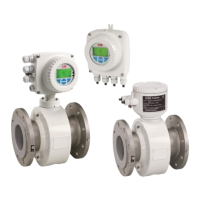
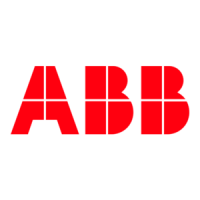
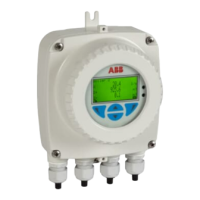
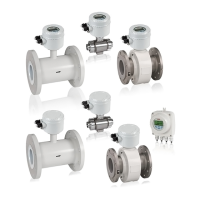




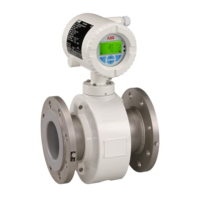
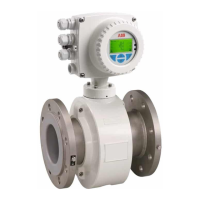

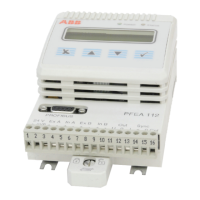
